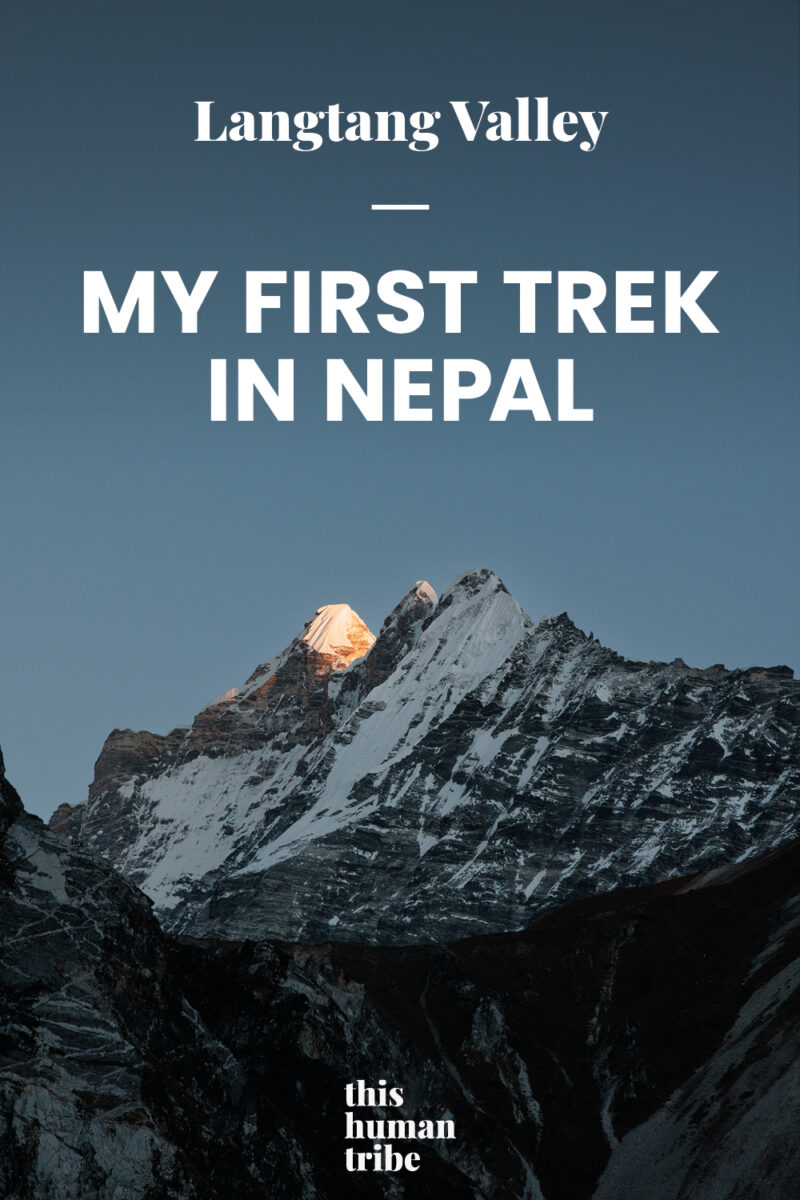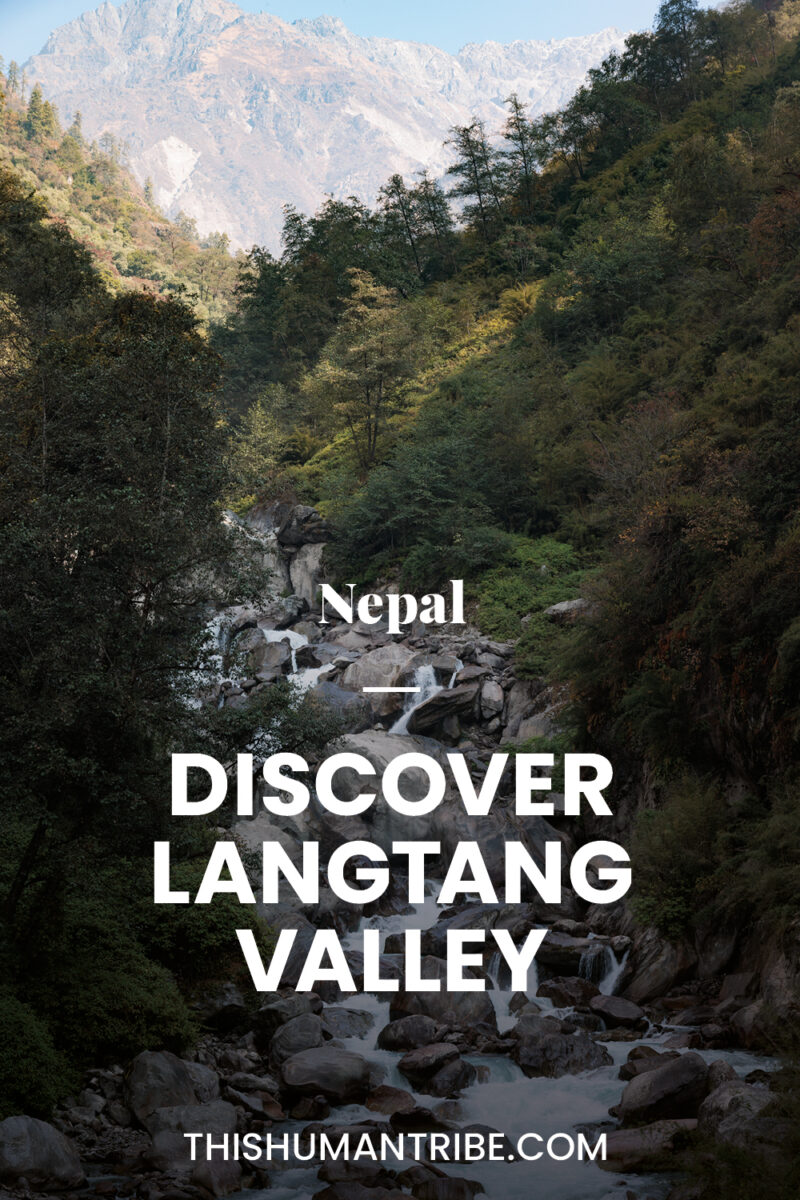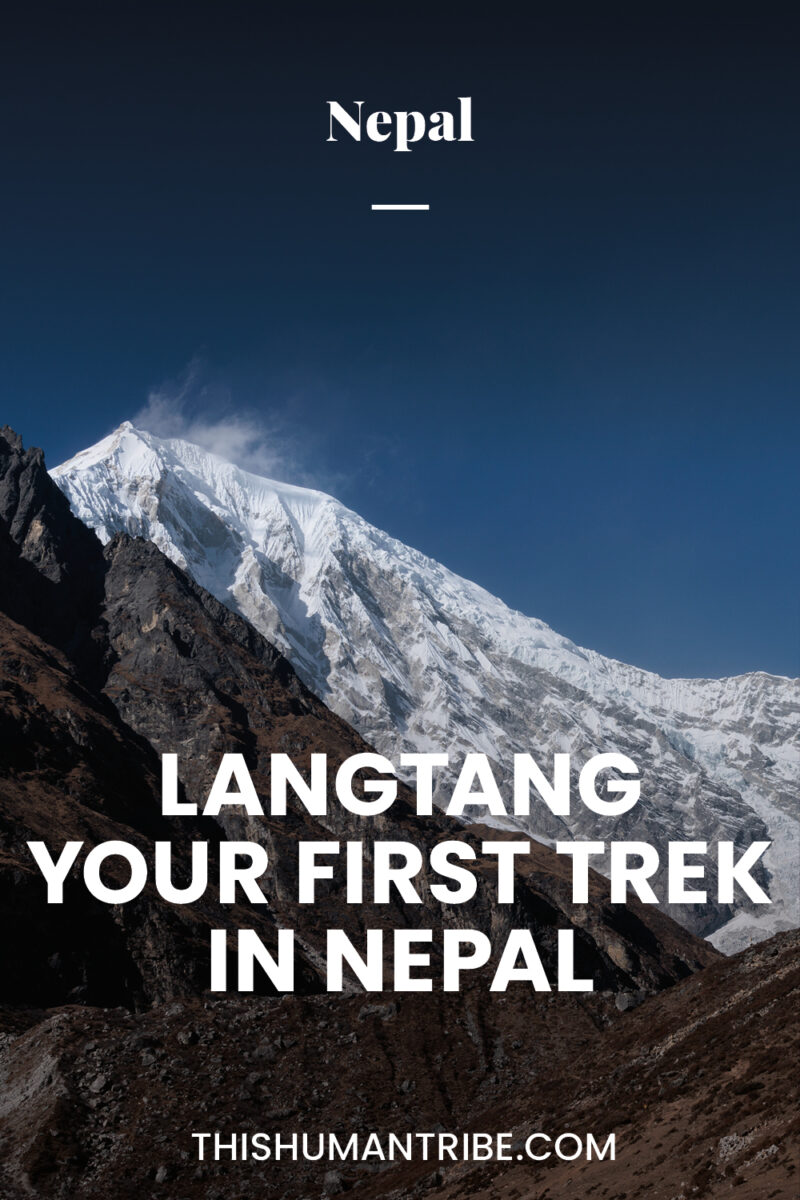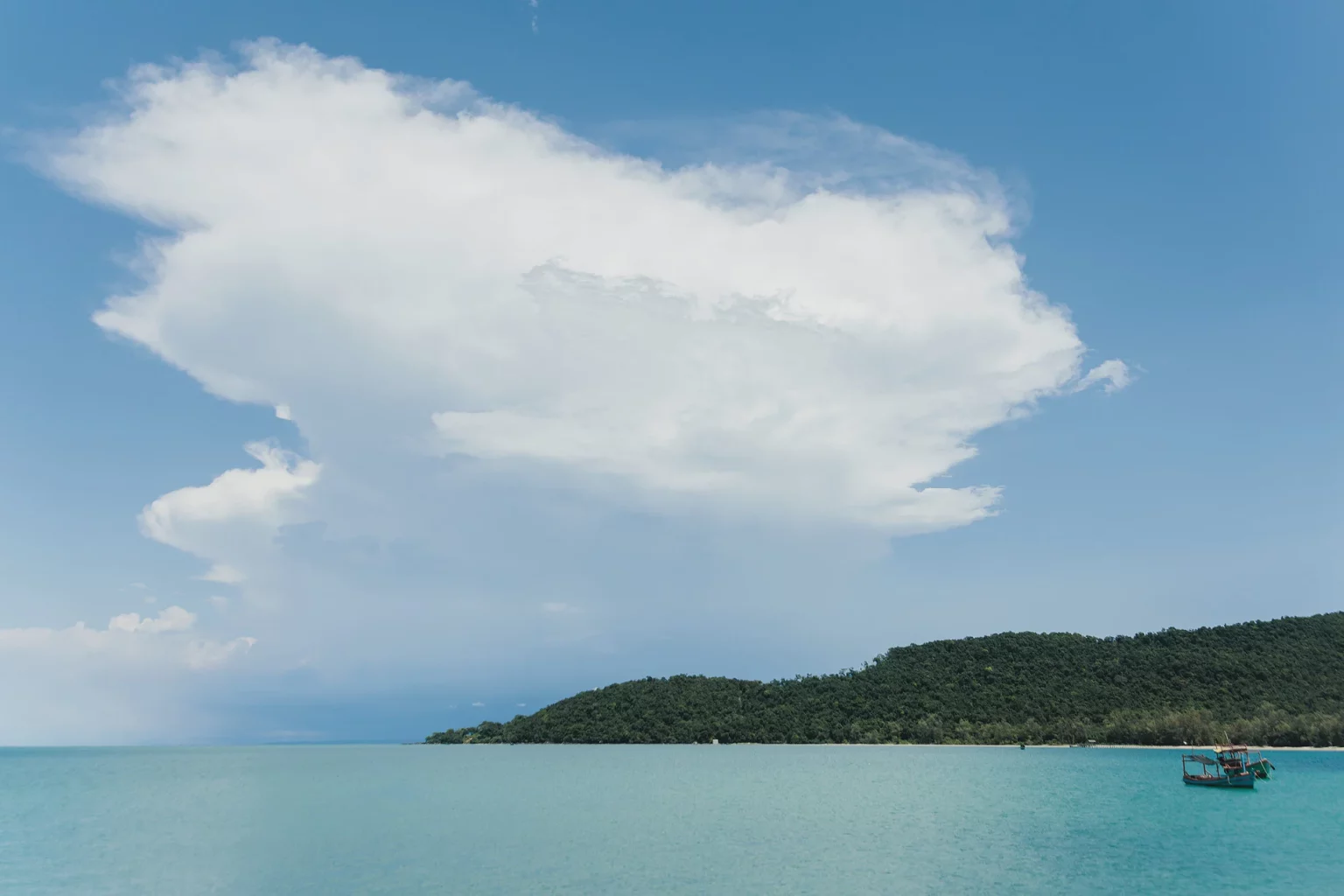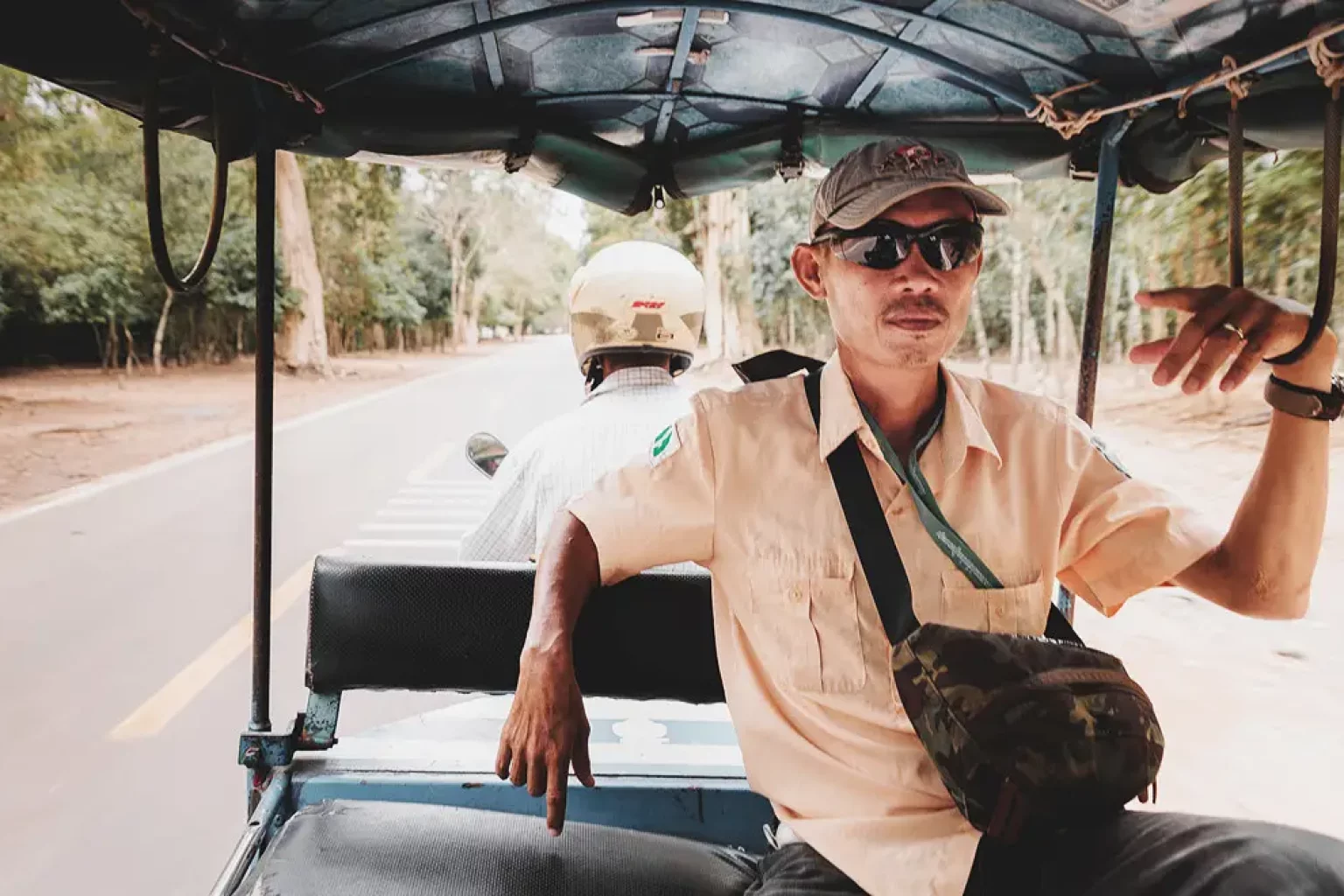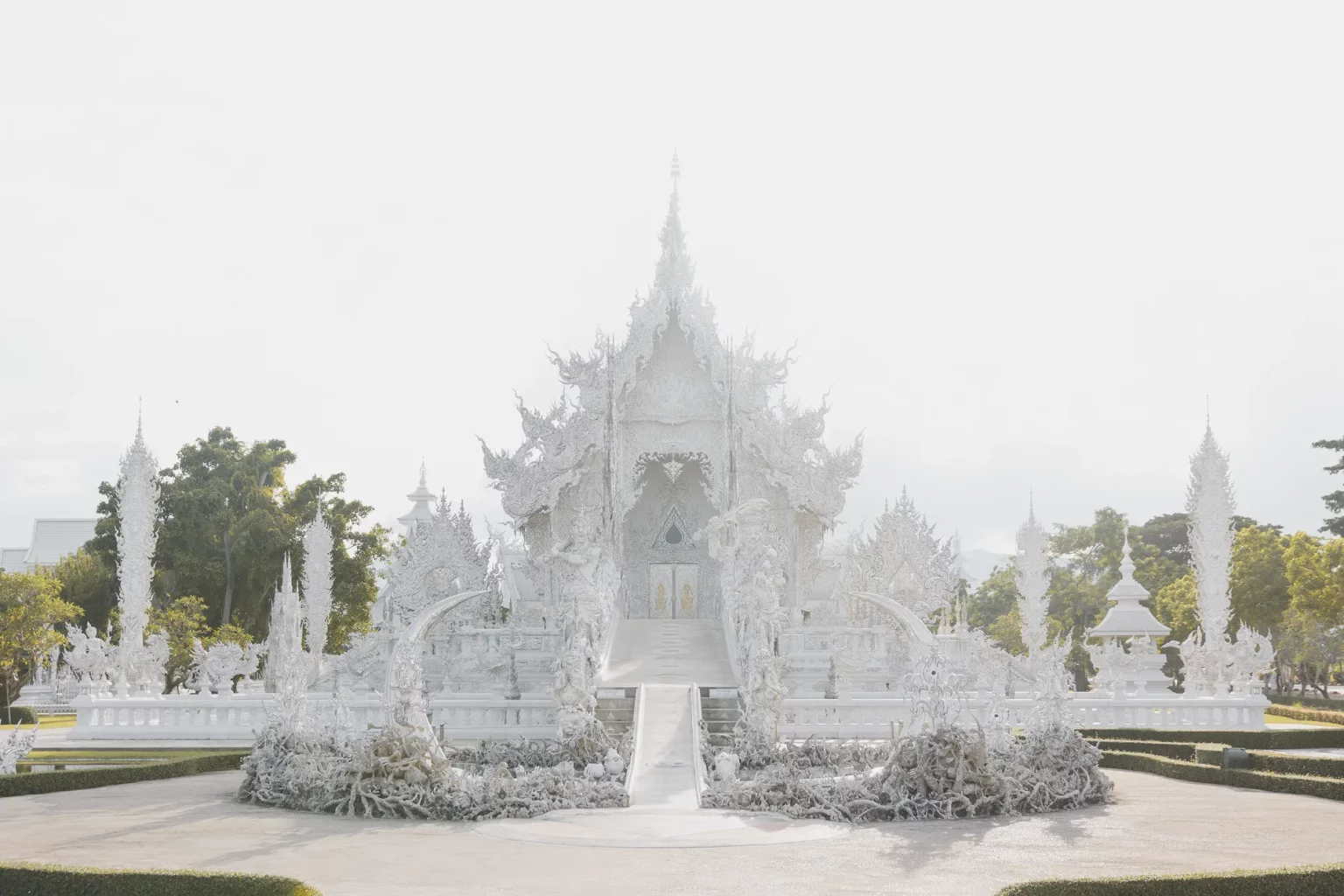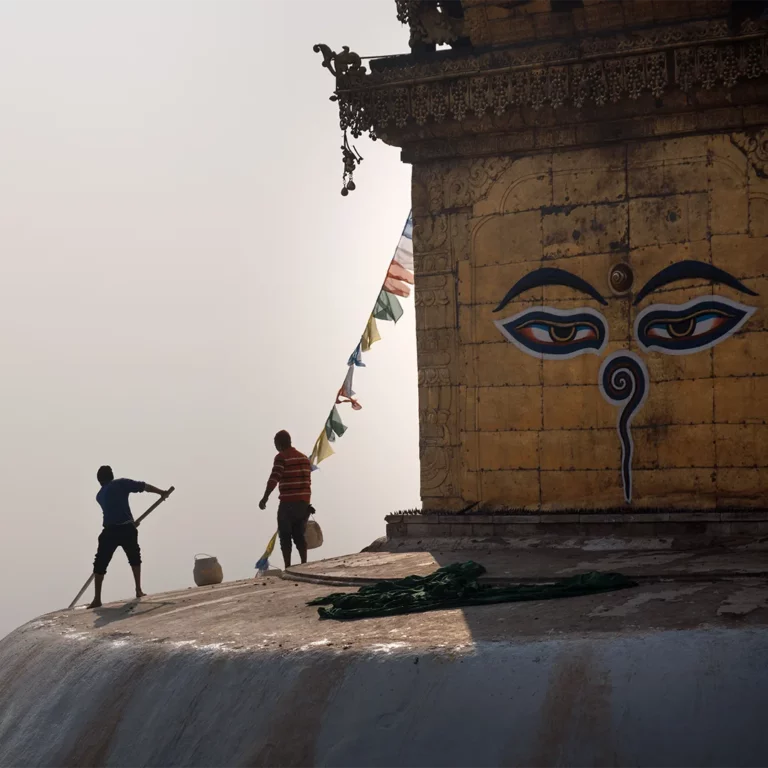I flew to Nepal with one main goal in mind: to attend a Thangka painting workshop. However, like many travellers visiting this breathtaking country, I decided to embark on at least one adventure close to the Himalayas. With little experience in trekking, especially in high altitude, I chose the Langtang Valley Trek for my first trek in Nepal. This moderate expedition, which can be completed in eight days, is both challenging and accessible to inexperienced long-distance hikers. The rewards for those who embark on this quest are to witness an incredible variety of wildlife, breathtaking landscapes and live meaningful cultural experiences.
The best moment to do this trail is during the months of spring or autumn. This article provides a day-to-day account of my trip at the end of November. It is designed to inspire you to visit this part of Nepal and to serve as a guide to help you prepare for your own journey.
Booking and Gearing
I reserved my hike through Sunshine Trekking Agency, finding it easier to rely on experienced professionals for my first trek in Nepal. They took care of all the bookings — including entrance to the national park, food, and matched me with a guide. Having arrived in Nepal after nine months of travelling in warmer climates, they also helped me to find the proper gear!
Thamel is the tourist hub of Kathmandu, a vibrant neighbourhood full of souvenir shops, bars, cafes, and, most notably, hiking stores. It can be overwhelming at first, but it is usually the area where travellers spend most of their time during their first visit to Kathmandu.
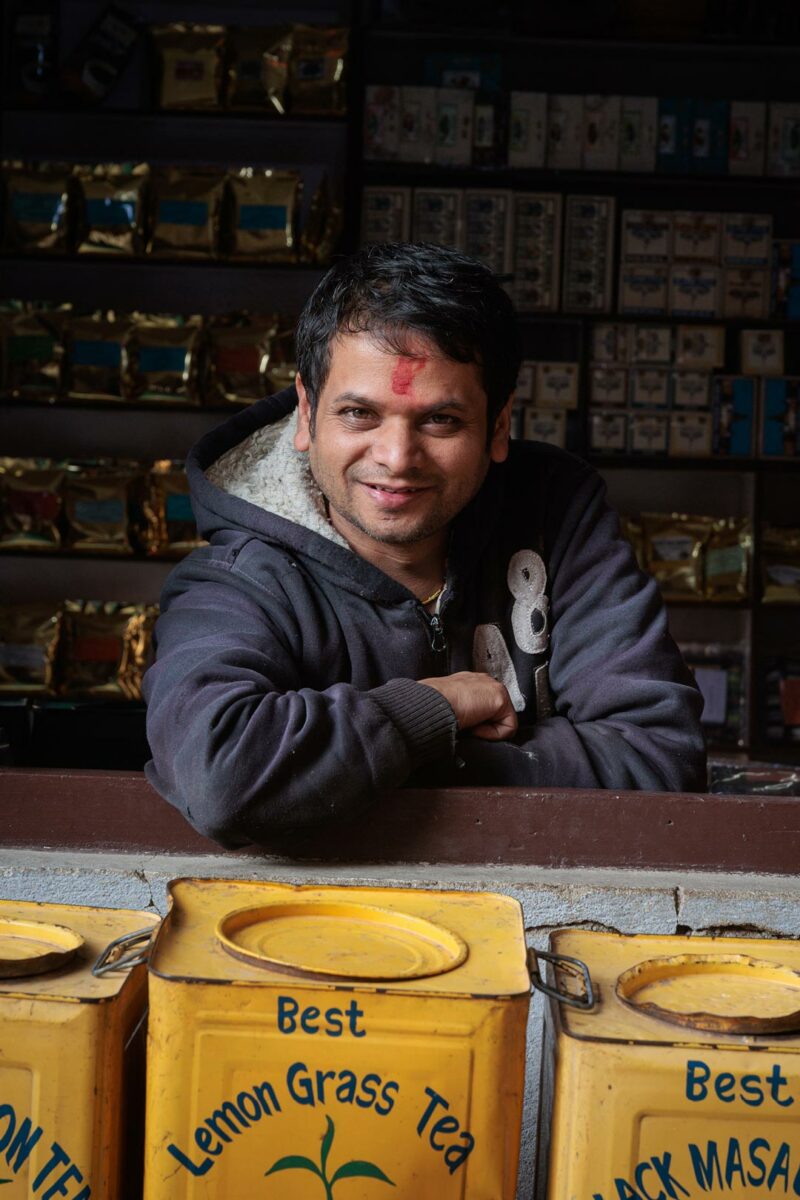
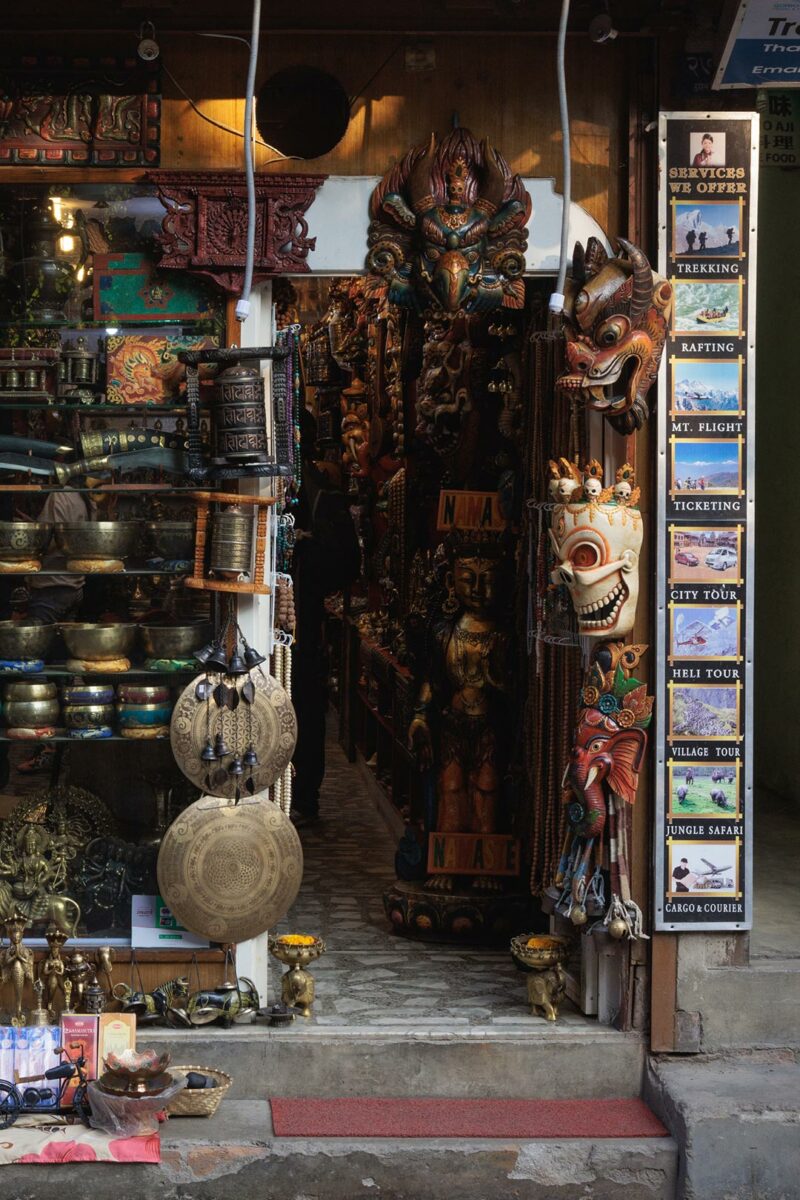
While most of the stores sell counterfeit items, some are of reasonably good quality. Although I do not endorse buying fake brands or would trust them for higher peaks, I felt secure with the equipment I purchased there.
Below are some tips to prepare your hike, if you want to jump to the day to day of the trek click here!
Quick tips to buy you gear for your first trek in Nepal:
- Consult Guides or Agencies: Talk with guides or agencies to find the best shops and know which equipment you need.
- Allocate Time: Plan some time to walk around Thamel, browse the stores, don’t feel obliged to buy, and decide after having checked several of them.
- Negotiate Prices: Especially if you are buying several items in one place.
- Temperature check: Ensure the clothes you picked are warm enough for where you are heading.
- Prioritise Quality Shoes: Make sure you have quality shoes; they are by far the most important item you’ll use!
Last thing to not forget:
- Drink clean water: The two best options for clean water are, life straw and aquatabs, both options are quite good but I found aquatab an easier solution for a short trek. It is also possible to drink boiled water. Avoid buying plastic bottles on the way.
- I got the power: If you depend on electricity for some of your devices such as camera, headlight or phone, invest in a good power bank. Several places I stopped where without electricity or paid electricity.
- Internet and phone: it is hard to stay connected, if you need to update someone of your progress, know that it is not always possible to find a network, even with a local sim. Wifi in your refuge may be quite expensive for a poor quality. Enjoy the deconnexion.
- Pack some snacks: It is a good idea to buy some nuts or bars for a quick snack during your hike. You are looking at burning anywhere around 3000 and 4.200 calories per day; trust me, you’ll be hungry.
In just a couple of days, I was equipped with a “North Fake” jacket, one warm sweater with a zipper, two long-sleeve T-shirts, one pair of convertible trousers, one pair of leggings, four pairs of warm socks, a wool hat, two walking sticks, a sleeping bag, and a box of water purifier tabs. I later discovered that there are also great Facebook groups for trading, buying, and selling second-hand gear. They are a good way to find some great equipment or pass on yours after your hike!
Day 01: From Kathmandu to Syabru Besi, Langtang Valley trek start
I woke up early at my homestay. I had arranged to leave most of my belongings there, just so I could travel with a small 45 litres backpack with only the essentials. Aising Gurung, my guide, was waiting for me. Drowsy, I gobbled a toast and an egg, and drank a tea before jumping in a taxi towards the bus station. The sun was rising in dusty Kathmandu.
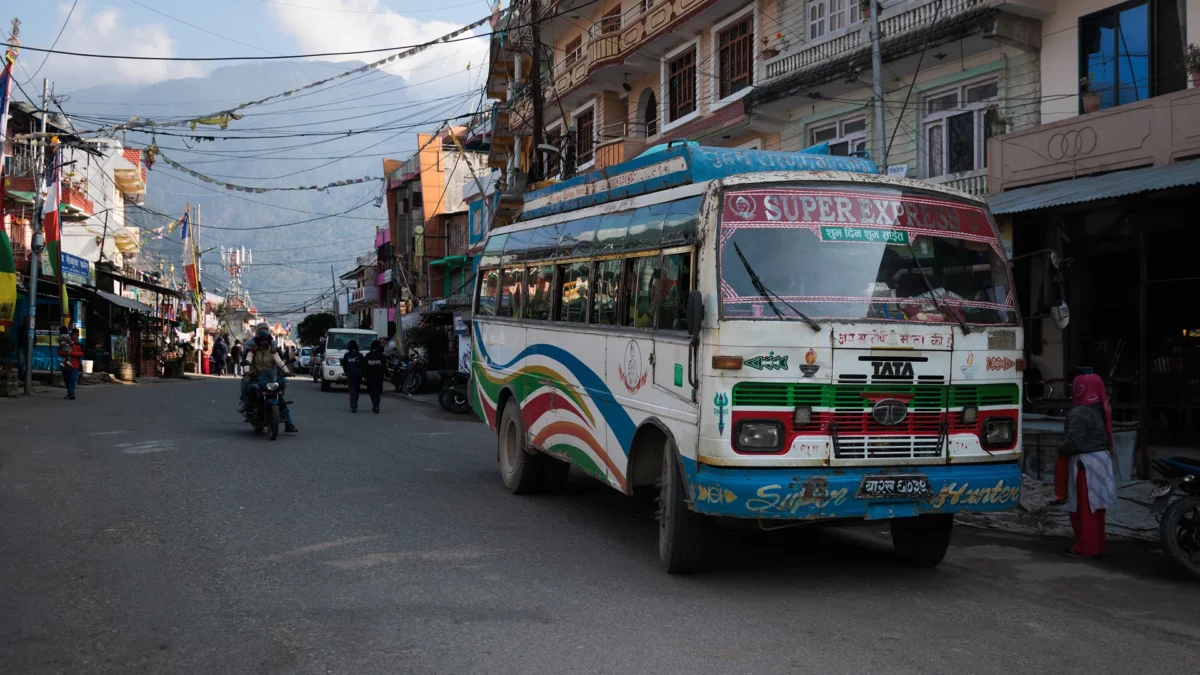
On the bus, I met other hikers, locals, and some tourists like me. I took a huge nap, and spent some time getting to know my guide. At lunchtime, we stopped by the roadside for some dal bhat.
Syabru Besi is situated at an altitude of 1,450 metres. It serves as a gateway to several treks, including the Tamang Heritage Trail, the Gosaikunda Lake trek, and, of course, the Langtang Valley trek. The tiny village consists of a single zigzagging street lined with hostels, guest houses, and a few shops where you can buy last-minute trekking gear at prices slightly higher and less negotiable than in Kathmandu.
I took a quick walk around the village and enjoyed a cup of tea in a café before heading back to my hostel. After a good dinner and a warm shower, I found sleep easily.
Kathmandu › Syabru Besi: 120km – bus ±8h
Day 02: First day of trek, on the way to Lama Hotel
We left our hostel around 7 in the morning, starting our descent towards the river. We soon arrived at the construction site of the new hydroelectric power plant. As we entered Langtang National Park, the path began to rise steadily. Oak, maple, and alder trees, as well as bamboo and rhododendron, dominated the landscape. There was a sense of calm and peace. Aising and I exchanged a few words but mostly walked in silence, enjoying the serenity that nature had to offer.
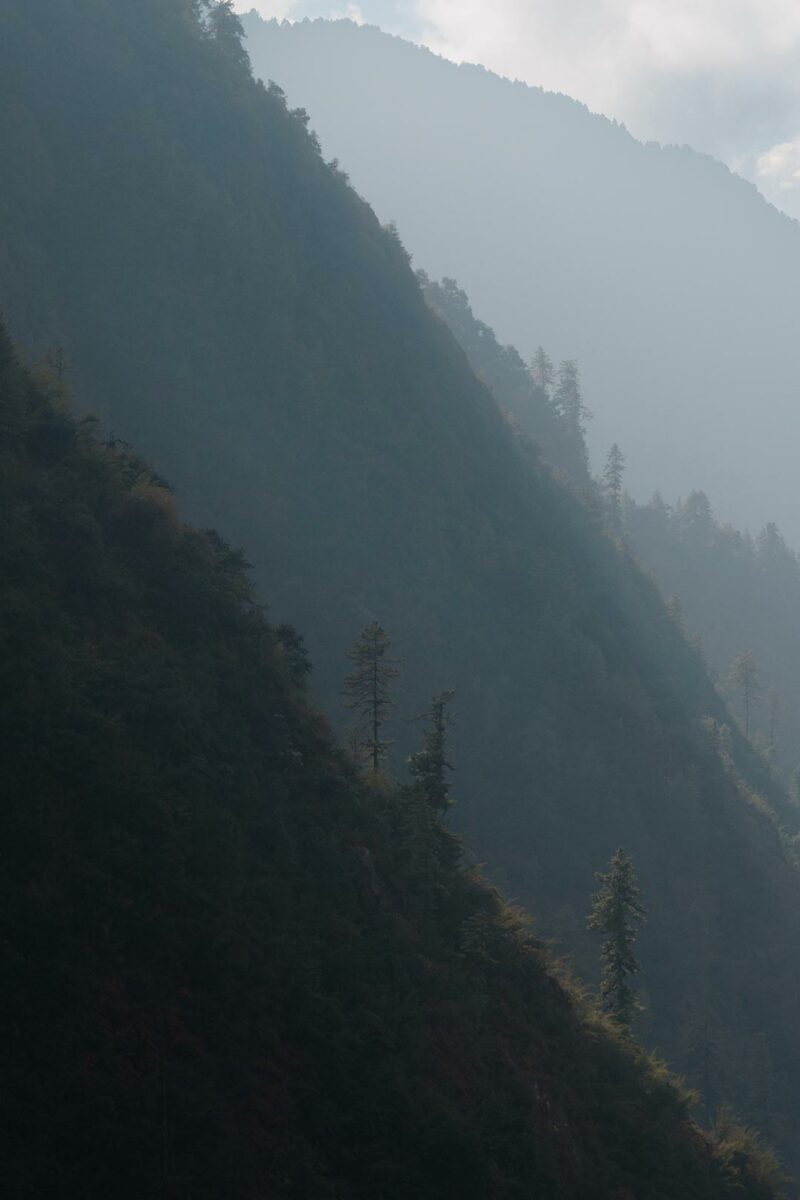
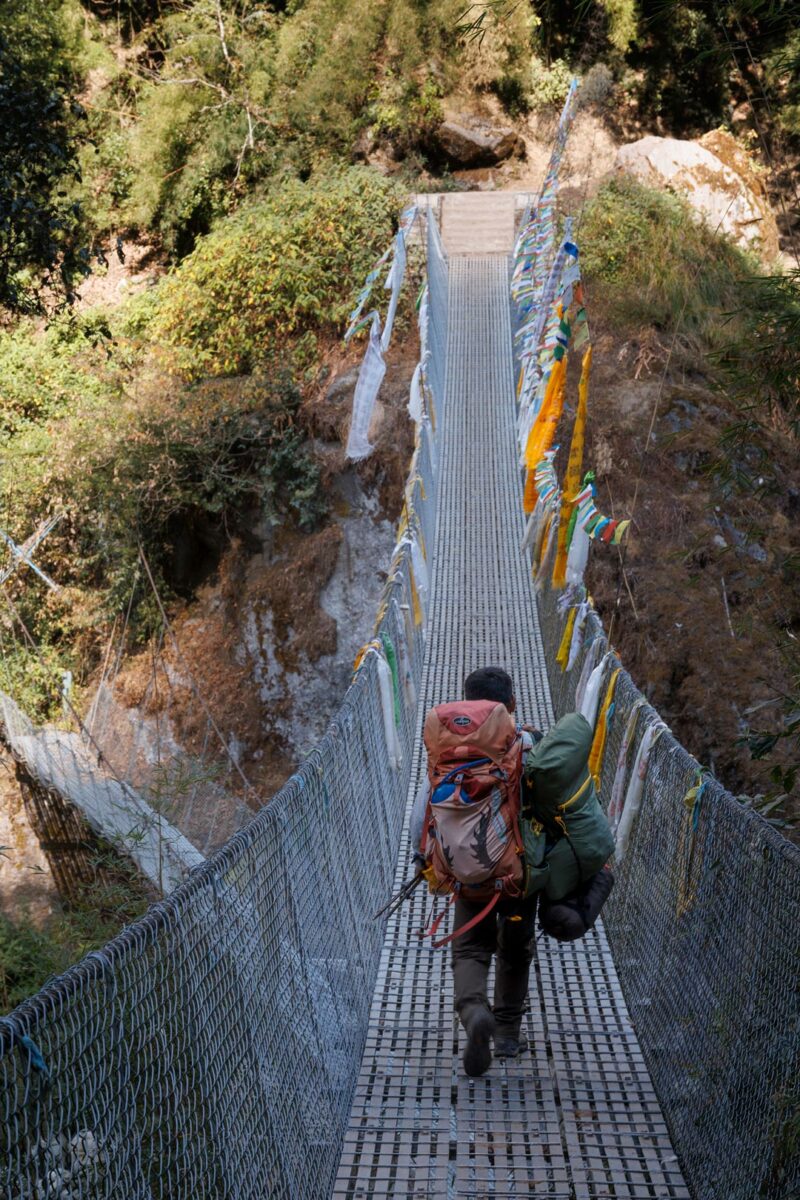
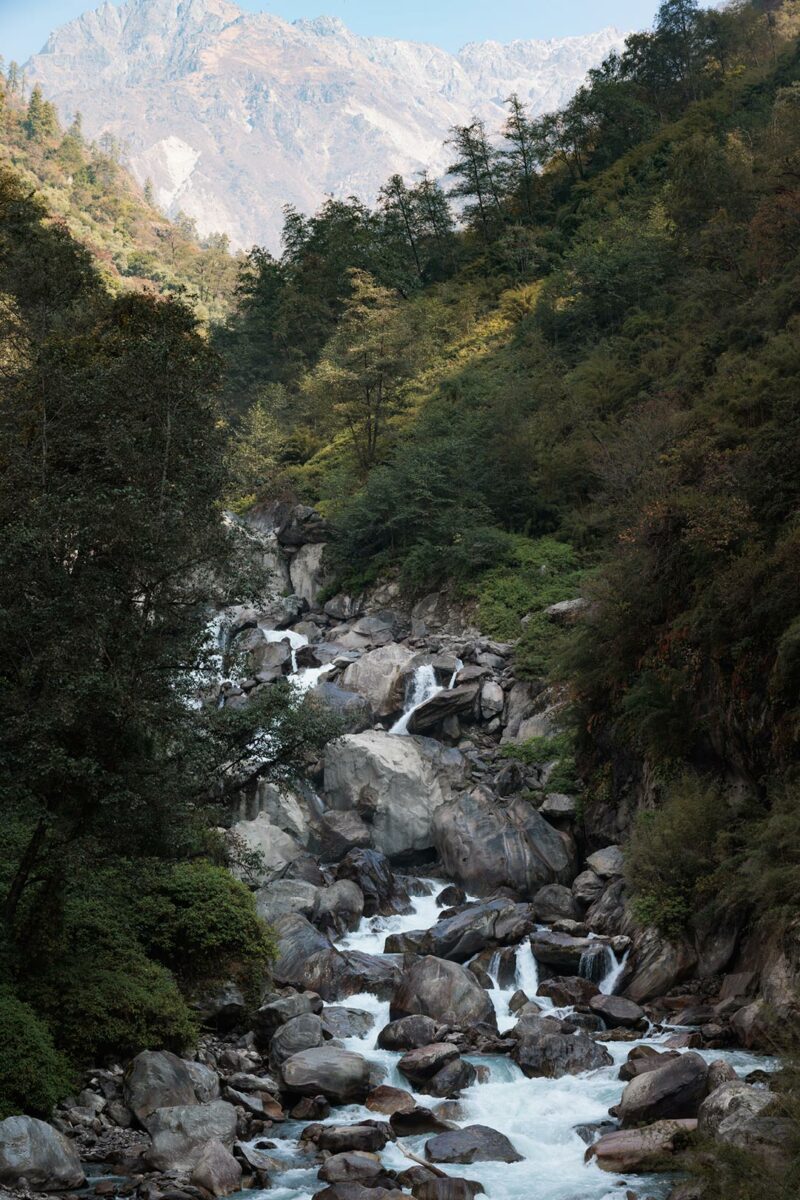
We crossed the river a few times on Nepali bridges. Standing above the river, I contemplated the different layers of nature: the mighty Langtang Khola splashing against huge rocks that were once part of the mountain, the lush forest on its banks, and the distant mountains, some coated with a white veil.
We continued walking like this for a couple of hours, taking small breaks. Slowly, I learned to adjust my walking pace and layer my clothing to stay comfortable. By mid-day, we stopped for food at a lodge along the river before finishing the first day of this trek at Lama Hotel.
Lama Hotel
Despite its name, Lama Hotel is composed of several identical hostels. The buildings have concrete walls painted in pastel colours, metal roofs, and wooden frames for the doors and windows, all decorated with years of faded stickers from different hiking companies and travellers. The entrance of my lodge, with its fire stove, serves as a kitchen, and another room follows and functions as a common area.
In the surroundings, the sound of the river provides a backdrop to the chatter of Sherpas and the laughter of children. A young man unloads his donkeys for the night while a girl takes care of her younger sister, as their parents, who manage the hostel, are busy preparing food.
The aroma of traditional Nepali spices filled the air, mingling with the scent of burning wood from the stove.




I dropped my bag in my room and joined Aising. I met some of my friends from the bus as well as other backpackers coming back down from their hike. After dinner, we all sat around the stove, getting to know each other and sharing stories of our day. By 9 pm, exhausted, we all went to bed.
Distance: 16,4 km – Elevation: +1165 / -160m – Timing: 6 hours of walk
Day 03: Lama Hotel Langtang to Kyanjin Gompa a.k.a. New Langtang
At six forty-five, my alarm rang, waking me to the fresh mountain air. Feeling rested, I quickly dressed and joined Aising for breakfast. I enjoyed a warm tea and pancakes while he briefed me on the day’s plan.
Ending his explanation he said:
— “If we’re lucky, we might see monkeys, and maybe even some red pandas!”
We left the hostel’s grounds and followed the forest path. As we climbed the steep trail, I noticed the changes in flora: fewer leafy trees and more pines. In the thinning forest, we spotted some yaks and, to our amazement, a troop of monkeys in the trees. We paused to observe them and took some blurry photos before continuing upward.
Emerging from the forest, we were greeted by the powerful sight of a waterfall crashing against the rocks on the mountain’s flank. In a nearby clearing, we saw a small isolated hut.
Aising tapped me on the shoulder and said:
— “Come, let’s have some milk!”
Mini Triber : Pasang Tamang
Life presents itself in various flavours, and for some, it tastes like nak milk—raw, earthy, and generous. Pasang, a yak herder from the Tamang caste, exemplifies this perfectly. He welcomed us into his tiny shack, built from roughly stacked rocks and covered with a thick plastic sheet. Hay blankets the floor of the room that serves as his bedroom, living room, and kitchen. Gathered around the fire, Pasang used a susu—a fire pipe—to blow on the ashes and revive the flames, warming up some of the milk for Aising and I.
Pasang explained how yaks migrate down the valley in autumn and return to the mountains in spring. He follows his herd, moving from one small shed to another every few weeks for about two months, carrying only essential belongings, food, and a tiny solar panel.
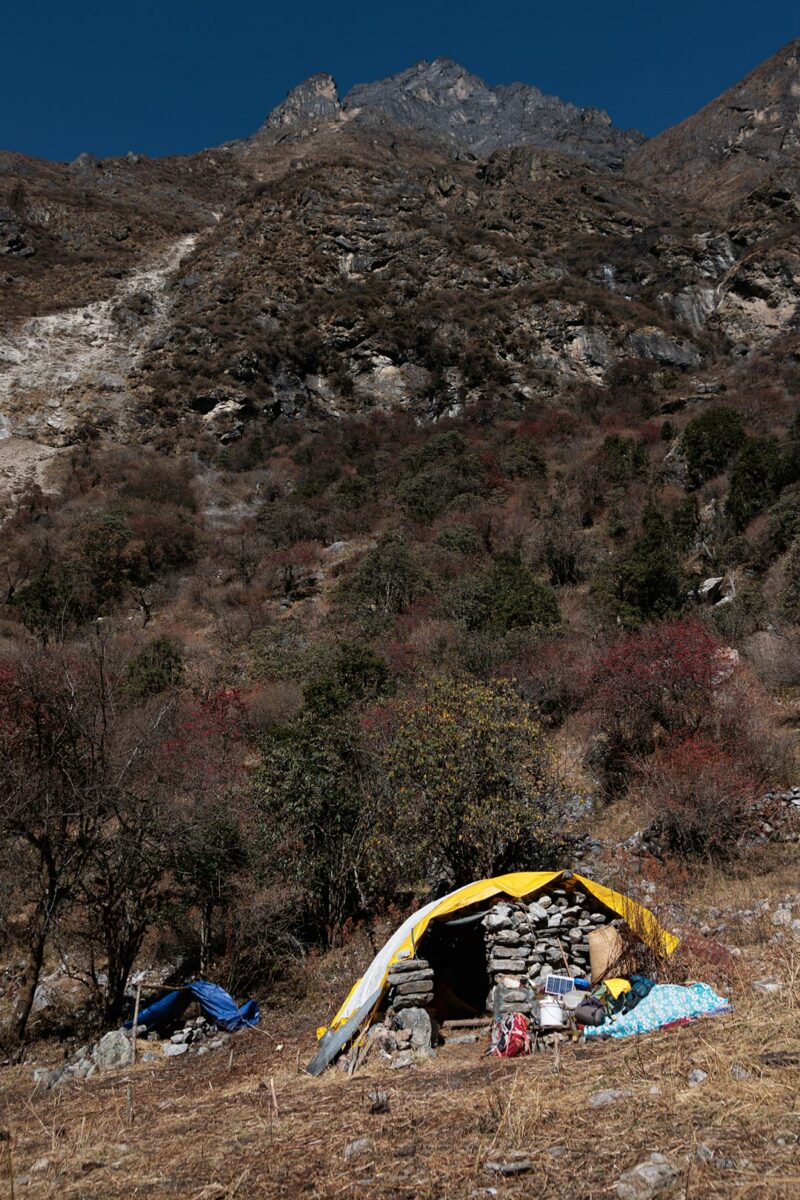
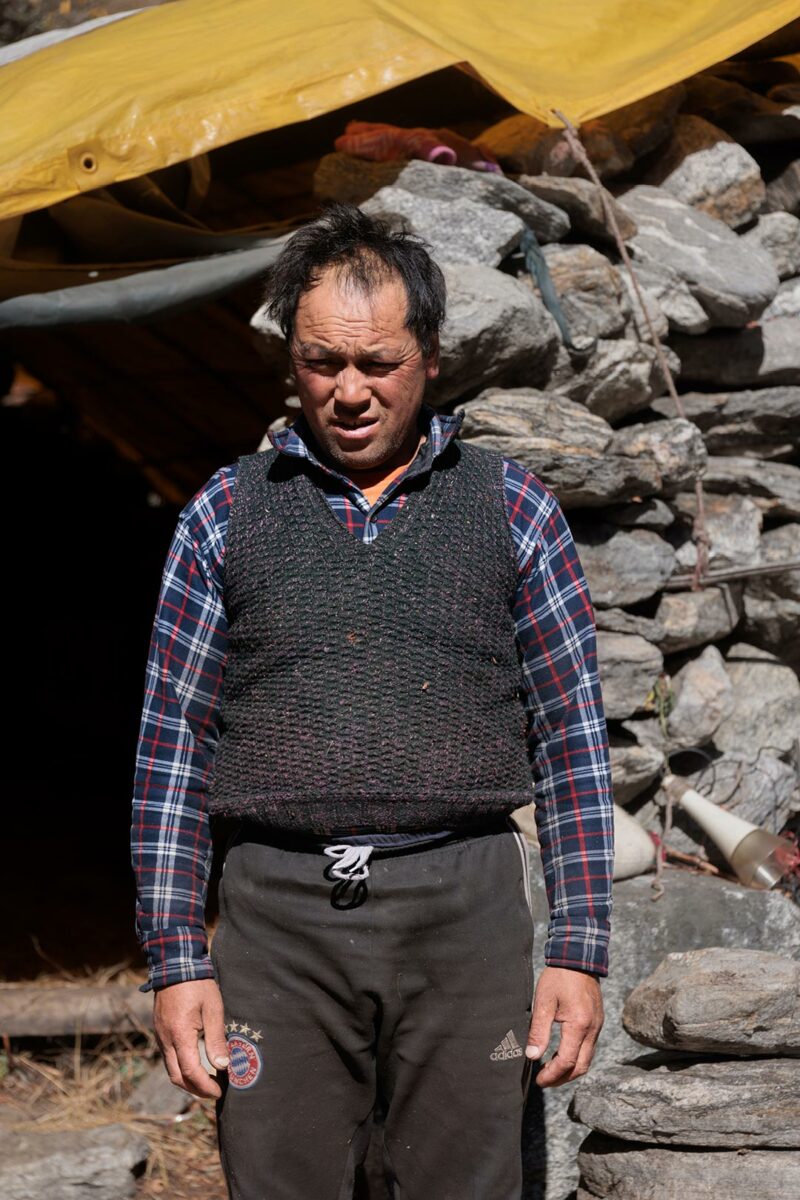
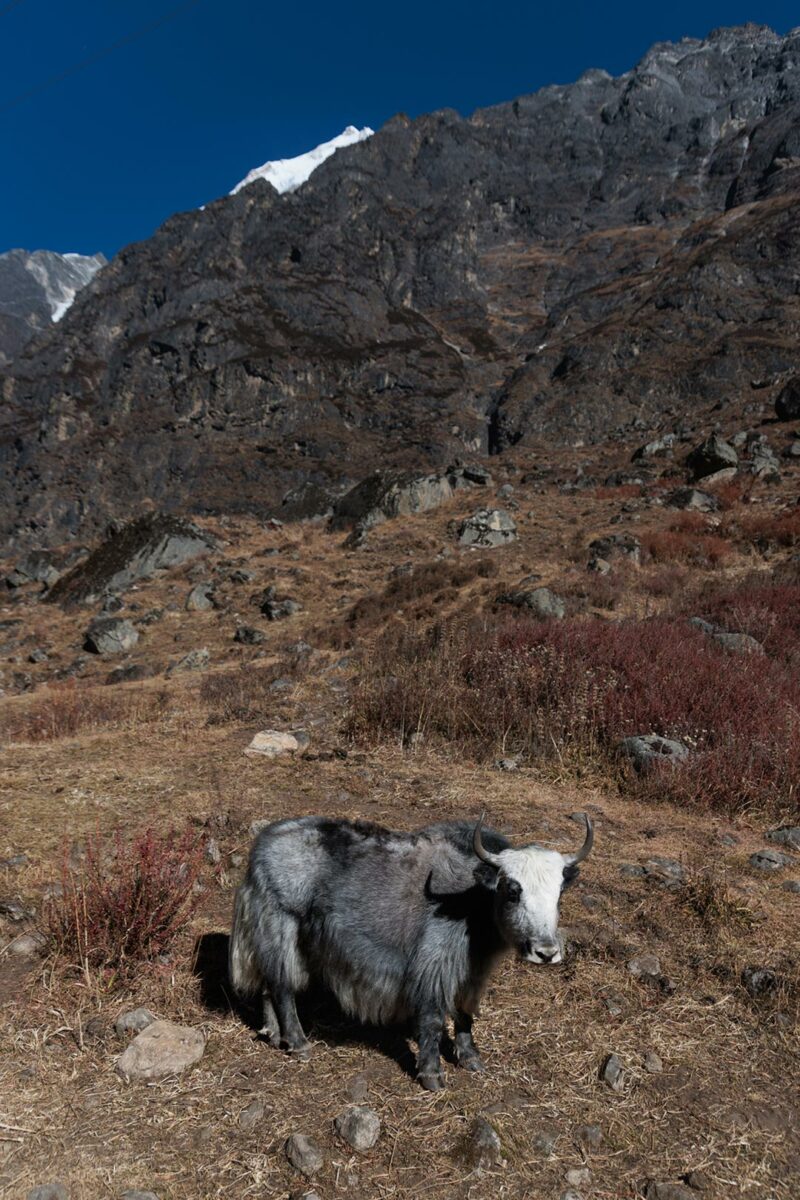
Observing Pasang’s lifestyle made me contemplate the diversity of life experiences on this earth. What may seem strange to one person is entirely ordinary to another. I felt fortunate to connect with such a diverse group of people during my journey.
Arriving in Kyanjin Gompa
Continuing our journey towards Kyanjin Gompa, we left the forest behind, making way for smaller shrubs as the distant Langtang Himal teased us with its white peak.
After hours of trekking, we encountered a vast landslide, where grey rocks starkly contrasted with the surrounding brown mountains. Carefully navigating a zigzagging path we crossed carefully accompanied by a porter and his donkey. It took me a while to realise that we were treading upon the remains of the old Langtang village, swept away in mere minutes during the devastating 2015 earthquake. There is a certain sense of powerlessness, understanding that so many people, local and travellers alike, lost their life in such a short time.




Shortly after having dropped our bags at the lodge, we took a stroll around the village, passing close to the stupa, we then settled on a hill to witness the sunset. Thick clouds began to roll in from the valley, draping New Langtang in a delicate silk veil. A silent reminder that it was time to come back to our hostel. Aising and one of his friends cooked for us before we all went to bed.
Distance: 18,8 km – Elevation: +1010 / -90m – Timing: 6 hours of walk
Day 04: Kyanjin Gompa to Kyangjin Kharka, the shortest day of my first trek in Nepal
This day was the shortest and easiest one of our trek, offering a much-needed breather after the previous challenging days. We strolled, relaxed, enjoying the surrounding beauty. We crossed herds of yaks and walked closer to the Langtang river while going around several small stupas and Mani stones.
Om Mani Padme Hum – ॐ मणि पद्मे हूँ
A mani stone is a construction made of several rocks, piled together and engraved with the mantra, “Om Mani Padme Hum”.This Mantra is associated with Avalokiteshvara, the bodhisattva of compassion. I immediately thought of Guan Yin, whose statues kept showing up on our path during our travels in Thailand and Vietnam. We walked around those formations clockwise, repeating the mantra hundreds of times.
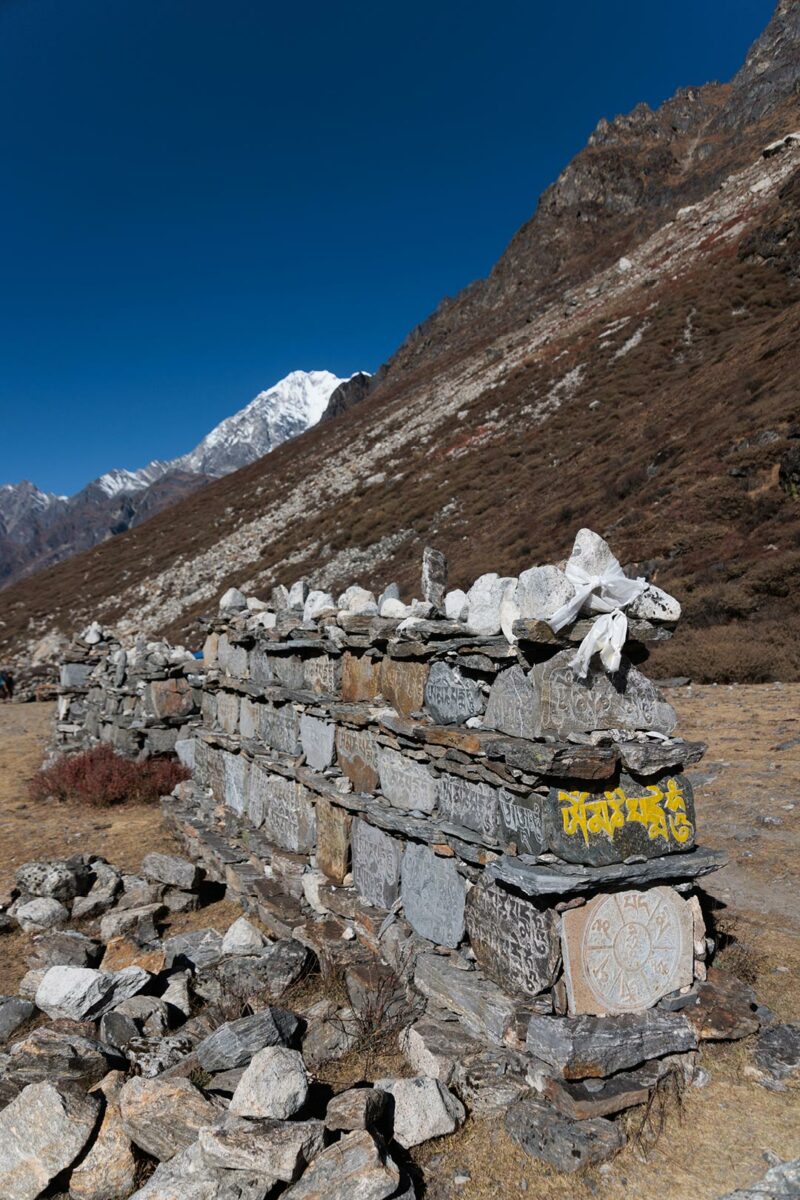
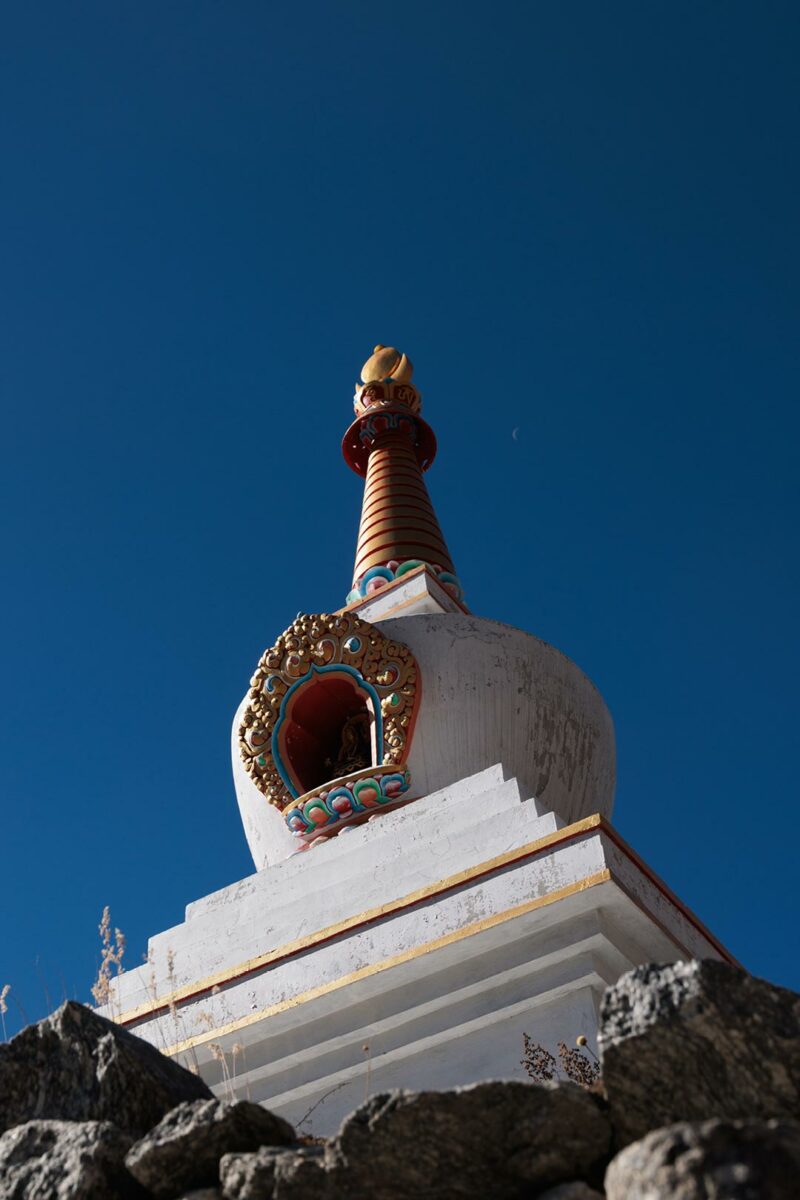
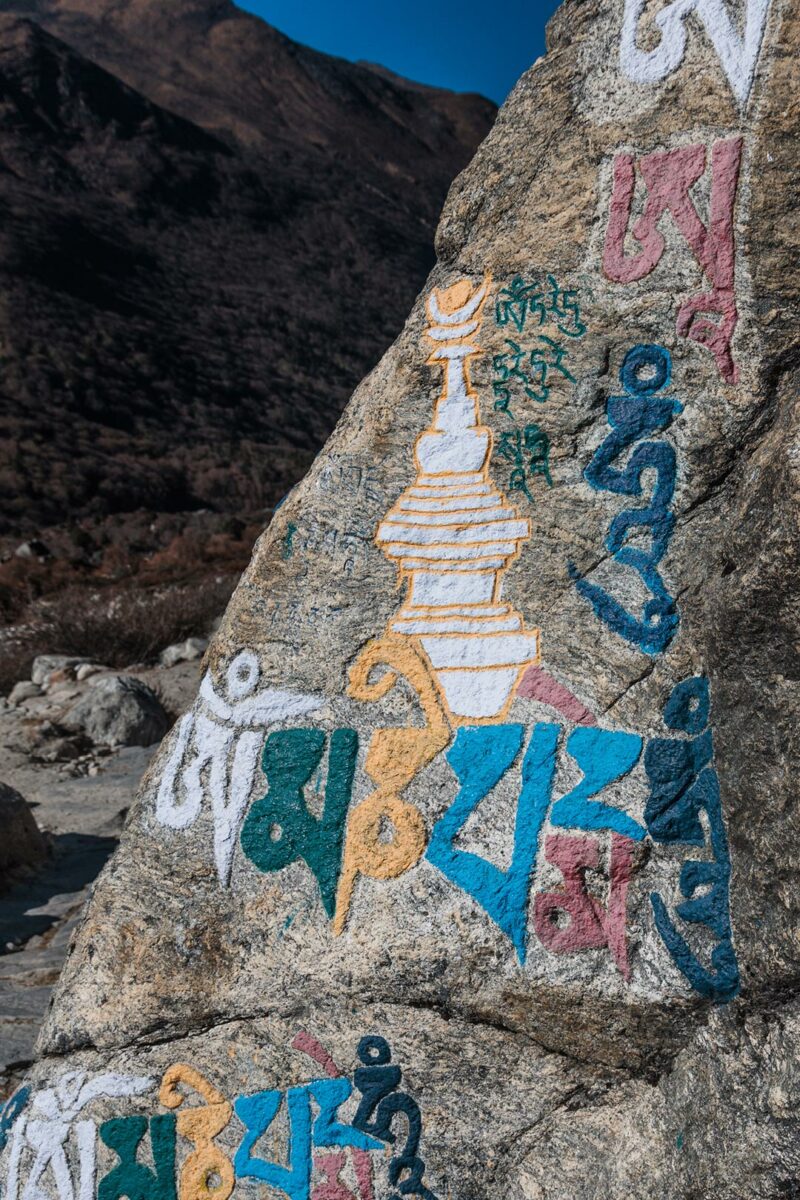
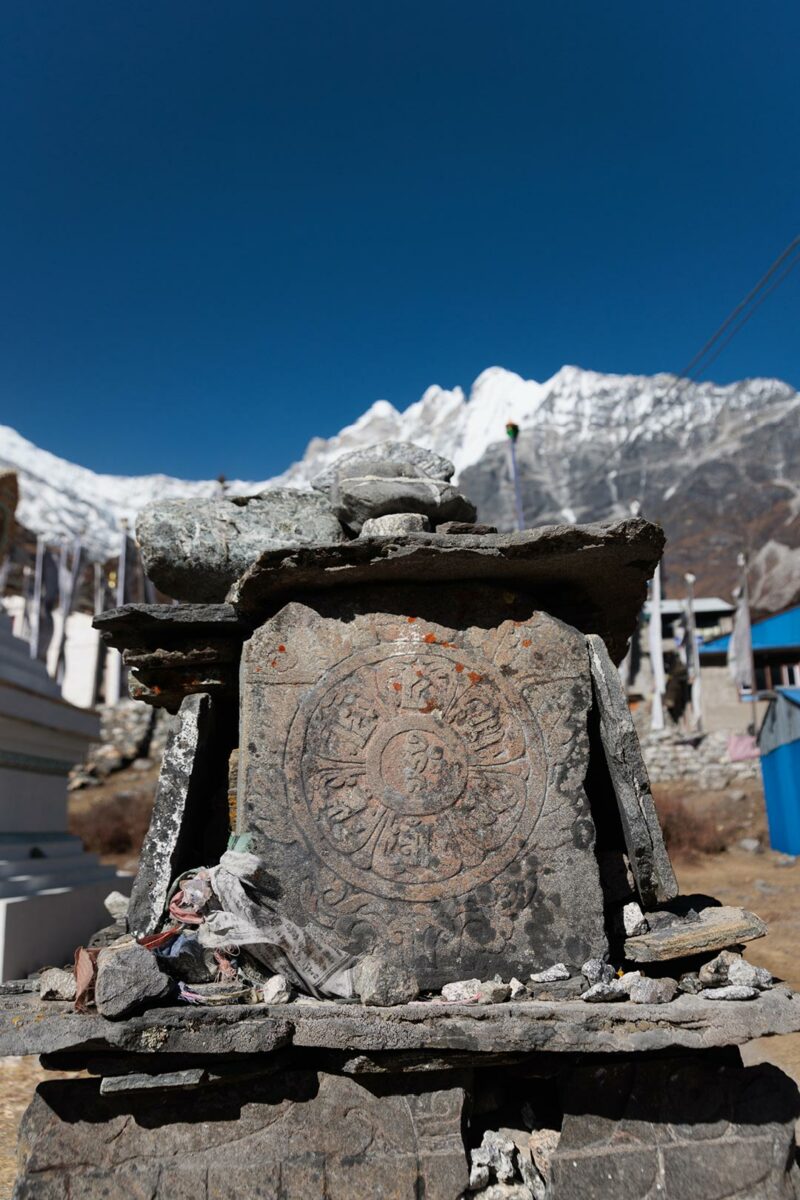
We got to Kyangjin Kharka around 10:30 in the morning, taking advantage of the sun to replenish our energy and getting acquainted with the altitude. In the afternoon I went for a walk, stopping to buy cheese in the nak cheese factory then visited the serene surroundings of the monastery.
Who takes out the trash?
As we wandered through the village, I stumbled upon a spot with a dump of garbage. The contrast with the pristine beauty of the mountains made me consider the impact of tourism on this fragile environment. It was a sad reminder of the responsibility we have as travellers to preserve the places we visit. Without preaching, think twice before drinking bottled water or bringing snacks wrapped in plastic!
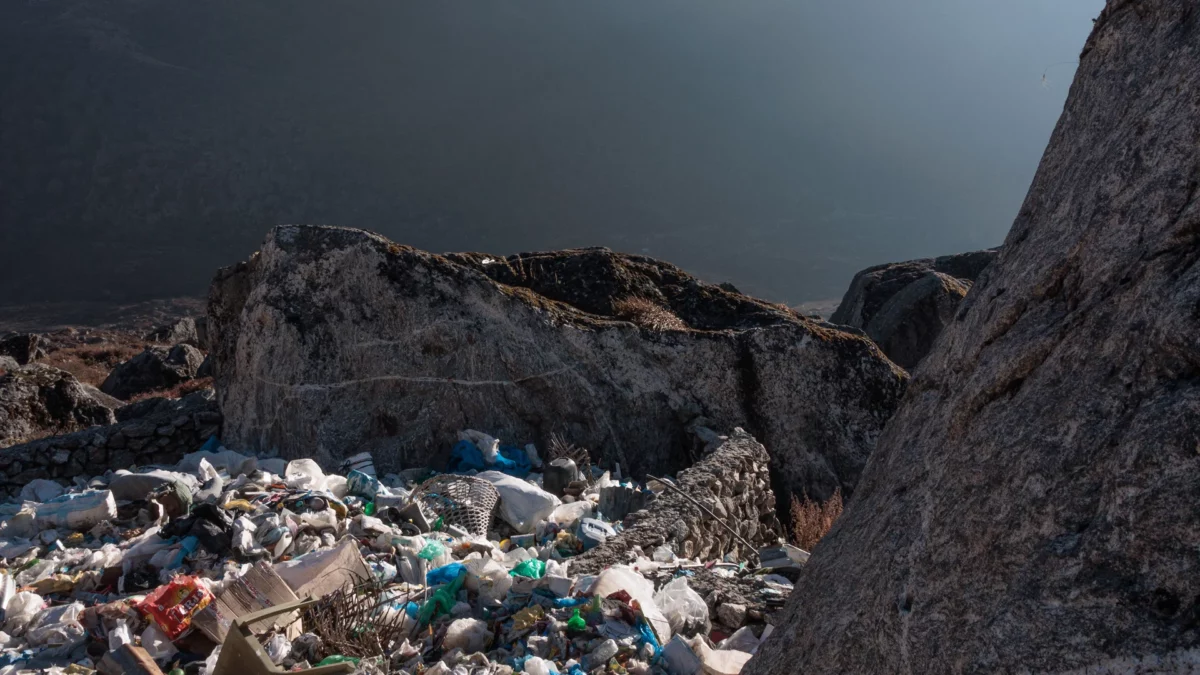
With an early start planned for the next day, we went to bed at 8 o’clock. However, I found it difficult to sleep, feeling a bit uneasy. Perhaps it was the altitude sickness creeping in, perhaps the anticipation of climbing Tserko Ri mountain and reaching for the first time an altitude of almost 5000m above sea level.
Distance: 9,9 km – Elevation: +460 / – 60m – Timing: 2h30 hours of walk
Day 05: The ascent of Tserko Ri
We woke up before dawn. The lobby was calm, a couple of souls sipping tea. After a copious breakfast, I filled my bottle with boiled water, geared up and we left. Outside, 5:30 in the morning, there was not a noise, just a group of motivated hikers lost in the dark with the moon as our sole pointer of direction.
We walked silently in the dark on a small path leading to the foot of Tserko Ri and started to climb uphill. The horizon slowly began to glow with the first light of dawn.
For the first two hours, we trekked in the shadow of the mountains, the path steep and challenging. The sun’s rays gradually illuminated the peaks of Langtang Mountain and the surrounding Himalayas, casting a breathtaking golden hue over the landscape. Finally, we were walking in the sun.





As we passed 4,500 metres, a light headache set in, a common symptom at such heights, but drinking water provided some immediate relief. Occasionally, I would pause to take photos, but I found myself slightly losing balance when looking through the viewfinder.
The final 200 metres were particularly demanding, forcing us to navigate between blocks of ice. The cold and the wind were more intense here. It was the only day I truly felt the chill through my gloves.
On the top of Tserko Ri mountain
As we ascended the last 50 metres to the highest point, a deafening concerto of flapping prayer flags surrounded us.
We reached the summit and were rewarded with a 360° view of the mountains. To the north-west, Langtang Lirung and Tsangbu Ri; to the north, an endless white expanse – Tibet; to the west, a view of the valley; and from east to south, Lönpo Gang and Gangchenpo peaks.
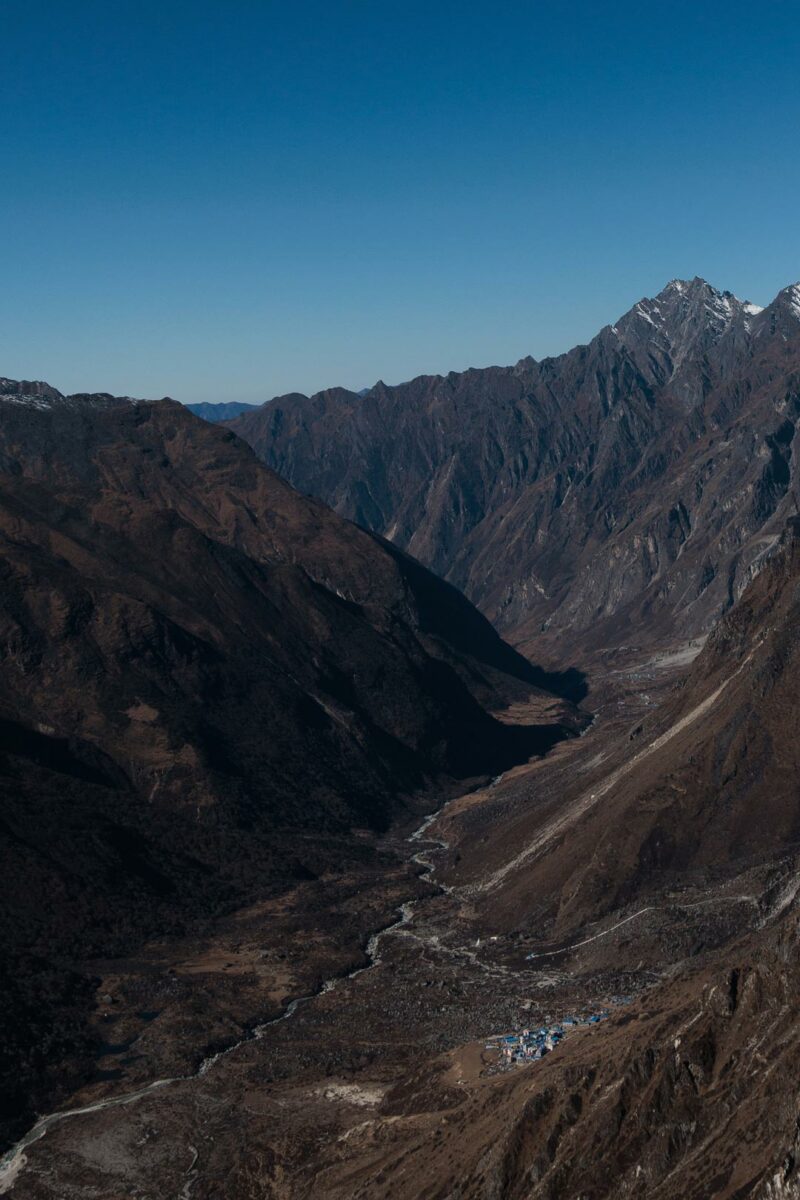
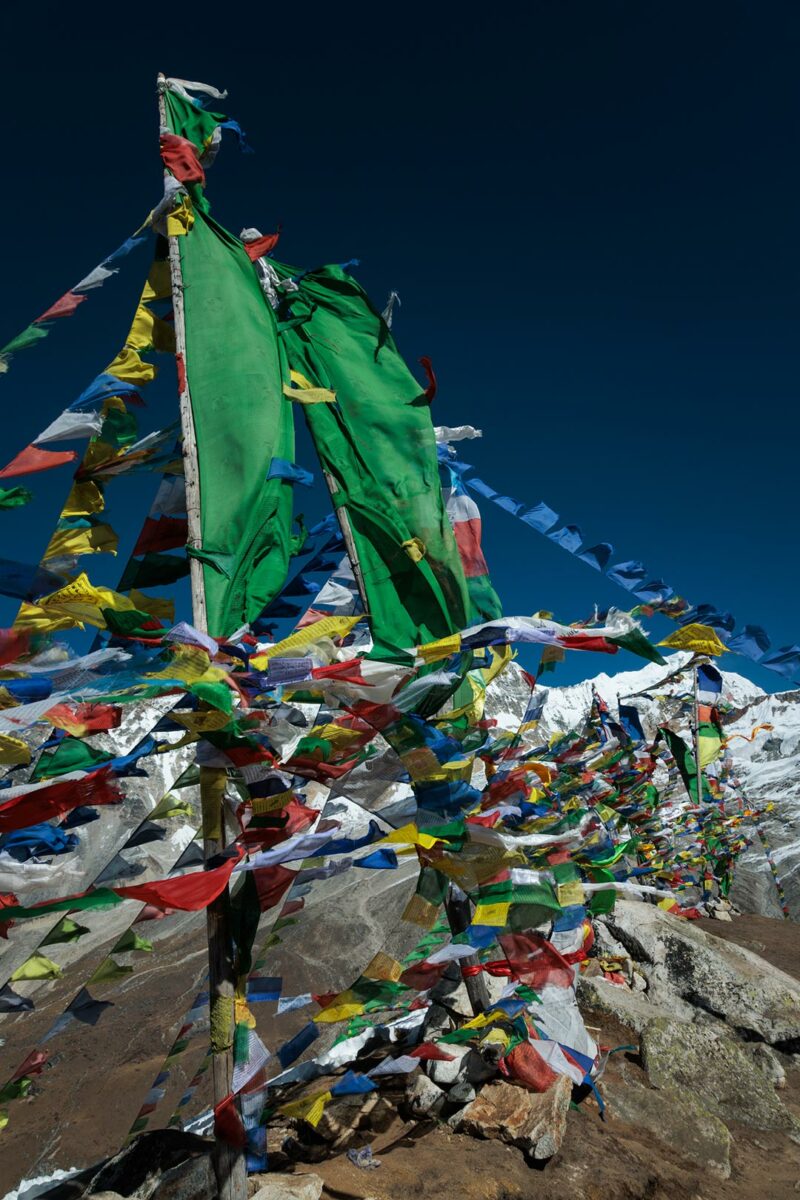
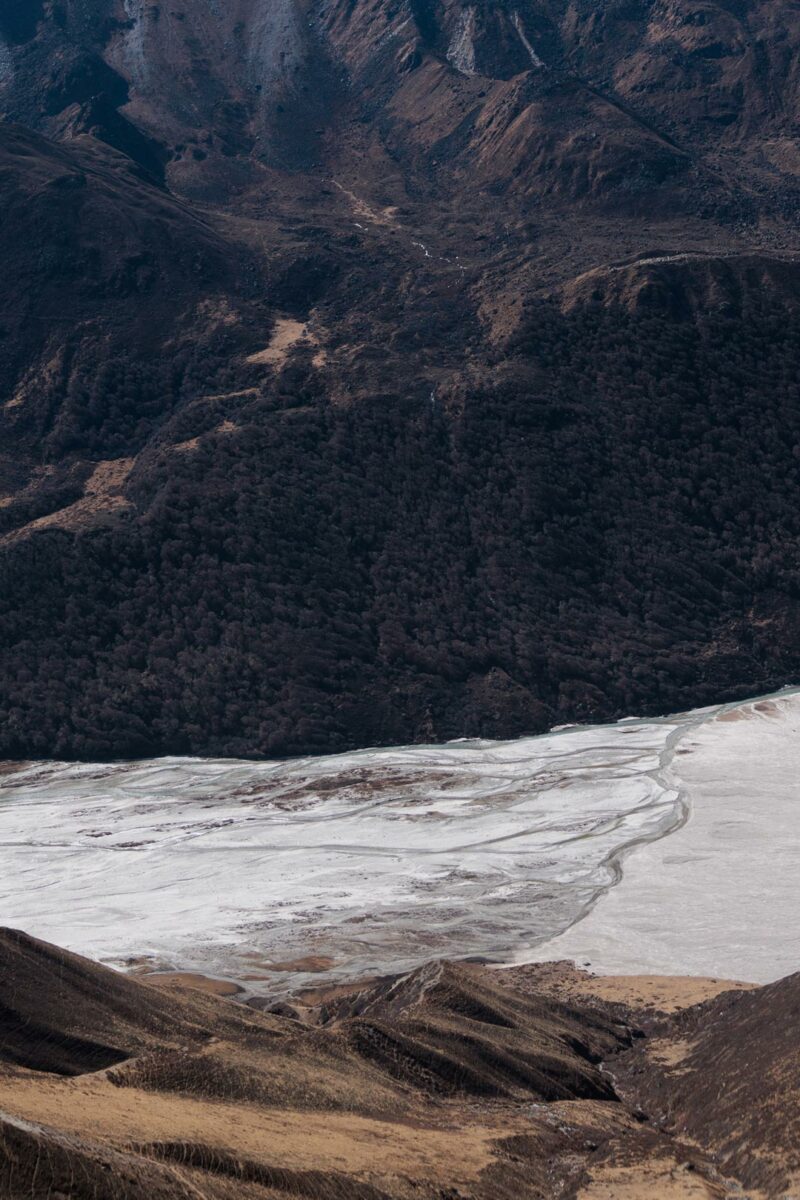
We sat on the east side of the mountain, sheltered from the wind and shared some snacks with a flock of red-billed choughs. After taking a couple of photos, we started making our way down. We took some detours, meeting locals carrying wood to the village.
We arrived back in the village before lunch and enjoyed a well-deserved afternoon of rest.
Distance: 12 km – Elevation: +1100 / – 1100m – Timing: 5h30 hours of walk
Day 06-07: Going back down Langtang Valley
We descended the valley in half the time it took to ascend. However, going down is not necessarily easier than going up! While climbing requires muscular strength, descending places significant demands on your joints, particularly the knees and ankles! This is where I found the walking stick most useful!
Walking down a path we’ve already traversed offered us a new perspective. We walked by the same stupas decorated with mantras, passed the same village, bid farewell to Pasang, and journeyed through the same forest. We greeted the same cheeky monkeys, encountered yaks, donkeys, and more. Yet, in the end, everything feels remarkably different!
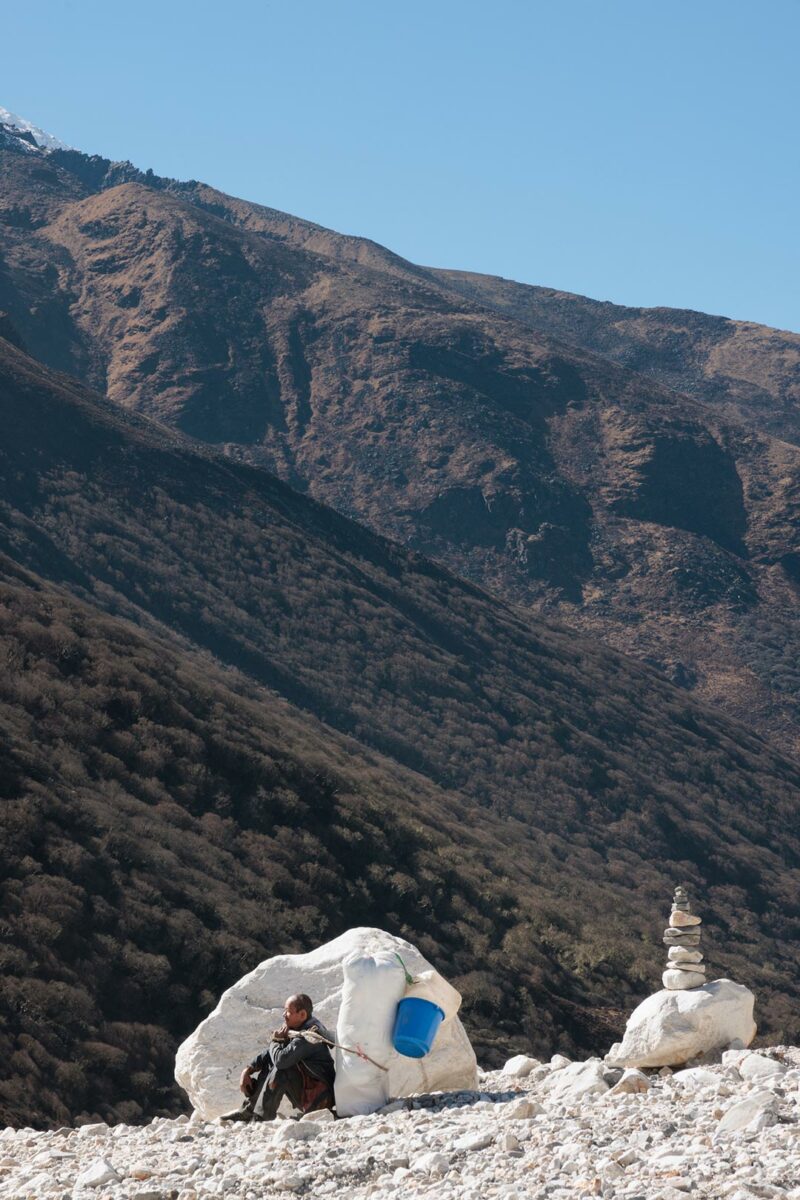
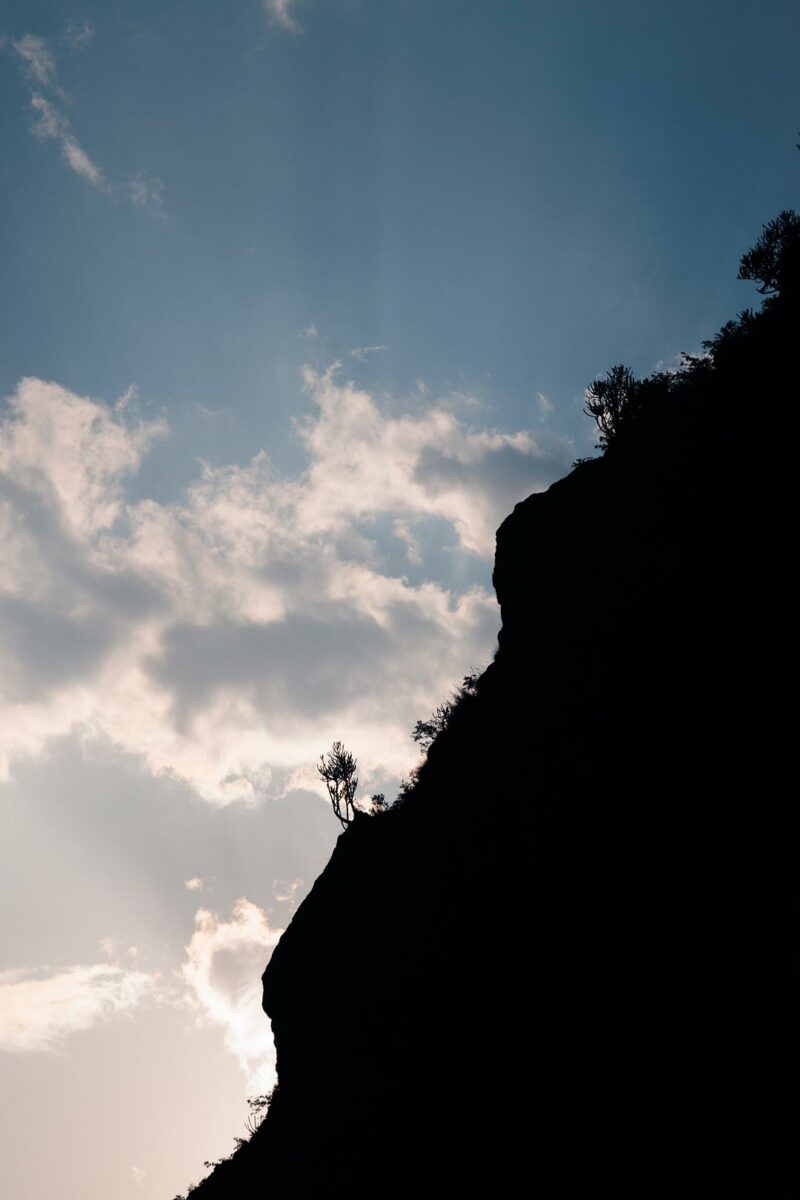

Two days later, we reached Syabru Besi. Aising and I shared a beer as we reflected on our journey. I felt a deep sense of accomplishment, yet simultaneously pondered over what exactly had been achieved.
We savoured the moment, relaxing before heading to bed.
Distance: 32,7 +13.1 km – Elevation: + 310 / -2870 m
Conclusion of my first trek in Nepal
I’m not sure if the mountain changes you, but I definitely felt a profound shift afterward. Perhaps it affirmed my capability for such experiences, deepened my connection to nature and the mountains. I also felt a certain calm and peace probably stirred by the spiritual aura that envelops these regions. Thinking back on this journey, it’s clear that each step carried meaning beyond the physical ascent.
If you’ve walked with me this far, I hope this article has ignited a spark within you—a yearning for the mountains, the snows, and the embrace of nature’s beauty. If it did, don’t hesitate to touch base with me, send me your travel impressions! Let me know how your first trek in Nepal went and, most of all, don’t forget to say hello to Pasang for me!
If you enjoy this article please pin it!
